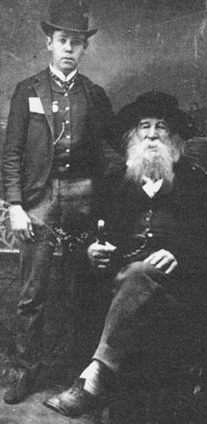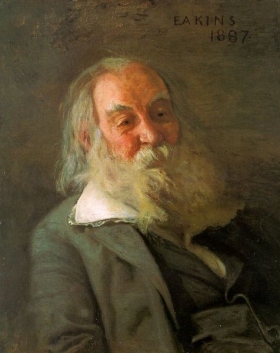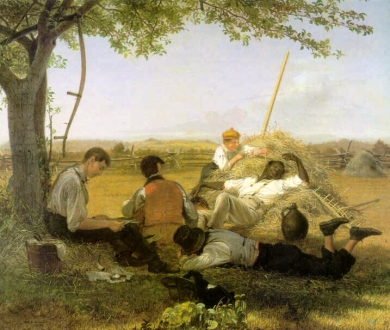|
Biography
/ History
|
|

|
Whitewashing
Whitman |
Academics
prevaricate, elide,
revise, and cover-up rather
than acknowledge that
the great poet
loved boys.
|
by Charley Shively
|
|
|
ALTHOUGH RELUCTANTLY,
many Whitman students now acknowledge that the poet's love of comrades
represented more than lip service. His affection for boys (those
below today's age of "consent" laws) has become the current taboo "love
that dare not speak its name.” Scholars, writers, magazines,
politicians, and gay boosters now recognize Whitman as gay, but they
deny he ever loved any boys.
 David S. Reynolds, in his Walt Whitman's America: A
Cultural
Biography (New York: Knopf, 1995) falls into this pattern with one
remarkable exception, his recovery of a "Sodom" story from Whitman's
teaching days on Long Island. Katherine Molinoff published a
pamphlet in 1966, Walt Whitman at Southold that collected the
testimonials of descendants whose oral tradition offers a remarkable
story. Reynolds summarizes: "As the story goes, one Sunday
(January 3, 1841, is the probable date) he [Whitman] was publicly
denounced by the Reverend Ralph Smith from the pulpit of Southold's
First Presbyterian Church `because of his behavior to the children, and
his goings on.' (Later on, reports of `bloody bedding' would emerge.)
Members of the congregation formed a furious mob and went to nearby
Kettle Hill, where hot tar was always available for mending fishing
nets. They hunted Whitman down at the home of George C.
Wells, whose son Giles was later said by Judge Jesse Case to have been
`one of Whitman's victims.' Whitman fled to the nearby home of
Dr. Ira Corwin, whose housekeeper, Selina Danes, known as `the
orphan's friend,' hid him in the attic. The pursuing townspeople
found him there, hiding under `straw ticks' (summer mattresses).
They seized him, plastered tar and feathers on his hair and clothes,
and rode him out of town on a rail." David S. Reynolds, in his Walt Whitman's America: A
Cultural
Biography (New York: Knopf, 1995) falls into this pattern with one
remarkable exception, his recovery of a "Sodom" story from Whitman's
teaching days on Long Island. Katherine Molinoff published a
pamphlet in 1966, Walt Whitman at Southold that collected the
testimonials of descendants whose oral tradition offers a remarkable
story. Reynolds summarizes: "As the story goes, one Sunday
(January 3, 1841, is the probable date) he [Whitman] was publicly
denounced by the Reverend Ralph Smith from the pulpit of Southold's
First Presbyterian Church `because of his behavior to the children, and
his goings on.' (Later on, reports of `bloody bedding' would emerge.)
Members of the congregation formed a furious mob and went to nearby
Kettle Hill, where hot tar was always available for mending fishing
nets. They hunted Whitman down at the home of George C.
Wells, whose son Giles was later said by Judge Jesse Case to have been
`one of Whitman's victims.' Whitman fled to the nearby home of
Dr. Ira Corwin, whose housekeeper, Selina Danes, known as `the
orphan's friend,' hid him in the attic. The pursuing townspeople
found him there, hiding under `straw ticks' (summer mattresses).
They seized him, plastered tar and feathers on his hair and clothes,
and rode him out of town on a rail."
In my earlier Whitman book (1986) I did not include this story.
In part this was because one of the Long Island towns had the name
"Sodom" (now Bay Shore) before Whitman was born, and that Sodom seemed
to have been conflated with Southold. Of course, Long Islanders
in the eighteenth century may have interpreted sodomy as the crime of
inhospitality. There is some new evidence now. Letters
between Whitman and a local doctor (Abraham Leech) from 1840s have
recently been published. While they don't mention the trouble,
they do not refute it. Other interviews with local residents
(including indirect descendants of Whitman) also add new twists.
Even so, the evidence is weak. In January 1841, Whitman was
supposedly tarred and feathered. Yet in March he wrote a letter
of reference for another schoolteacher.
Tarring and feathering does not prove a sexual crime. At the very
least, the incident should be put into a wider context. Whitman's
chief persecutor, a Presbyterian minister trained at Princeton,
represented the New England and Whig communities on eastern Long
Island. Whitman came from the more Democratic, Quaker,
freethinking Dutch section of the island. His letters with Leech
show him to be a supercilious, haughty, somewhat Byronic
individual. That attitude could hardly have endeared him to his
opponents. In the November elections of 1840, he worked for the
Democratic candidate Martin Van Buren ("Van, Van's a Used Up Man," the
successful Log-Cabiners for William Henry Harrison claimed). A
letter from November 28, 1840, from a lawyer in Washington to a
Southold resident refers thus to Whitman's position in the 1840
election: "I am most sincerely sorry that Whitman tho't it expedient to
`run a muck' under the chariot wheels of `old Tip'-but hope he may
escape unscathed.” (71) Could this letter suggest that a
Tippy-Canoe-and-Tyler-Too mob had attacked Whitman?
Reynolds, nonetheless, should be praised for breaking the Log Cabin
Club taboo on boy-love. On the other hand, he accepts
uncritically the current dogma about men and boys sleeping together
being so common: "In those days, it was not unusual for a male teacher
boarding with his students' families to sleep in the attic with one or
more of the boys.” And later, in analyzing a Whitman story from
November 1841, Reynolds writes that the man takes the boy "to an inn,
where the two sleep together according to the common custom of the
day.” (76) Where is the evidence for such "common custom"?
And if it were common, did the night go the way Petronius wrote in his
first century Satyricon: the tutor whispered in the boy's ear, give me
my pleasure and you'll get a gift tomorrow; after a few nights of this
the boy got greedy, the tutor then said, be more modest or I'll report
you to your father.
After a good beginning, however, Reynolds soon backslides. He
totally distorts Whitman's relationship with Billy Duckett: "He was
aided in his driving by a roguish teenager, William Duckett, who
boarded for a while at Mickle Street. Although Whitman liked
Duckett, who accompanied him on out-of-town trips.... Mrs. Davis
got into a financial dispute with the young man, who falsely
claimed the poet had invited him to stay in his house for free.”
Reynolds doesn't mention that Whitman shared his bed with
Duckett. Nor does Duckett's name appear in the index.
 An interesting
discovery (although not exactly overtly presented) comes
in Whitman's relations with the artist William Sidney Mount.
Mount painted Whitman's schoolhouse in Southold (the name was later
painted over) and he painted a group of Long Island youth. In
Farmers Nooning (1836), the boys lounge with their eyes focused a black
man's crotch. Whitman recalled in his Specimen Days a West Hills
liberated slave who was very "manly, and cute and a great friend of my
childhood.” (20) Without any authority, Reynolds changes the word
"cute" to "[a] cute." An interesting
discovery (although not exactly overtly presented) comes
in Whitman's relations with the artist William Sidney Mount.
Mount painted Whitman's schoolhouse in Southold (the name was later
painted over) and he painted a group of Long Island youth. In
Farmers Nooning (1836), the boys lounge with their eyes focused a black
man's crotch. Whitman recalled in his Specimen Days a West Hills
liberated slave who was very "manly, and cute and a great friend of my
childhood.” (20) Without any authority, Reynolds changes the word
"cute" to "[a] cute."
The academy has made way for homosexuality, but it has not welcomed
man/boy love.
|
From
the NAMBLA Bulletin, Vol. 16, No. 2, Pgs. 32 - 33, Aug.
1995.
|
Copyright © NAMBLA, 2008
|
|
|
|
|

